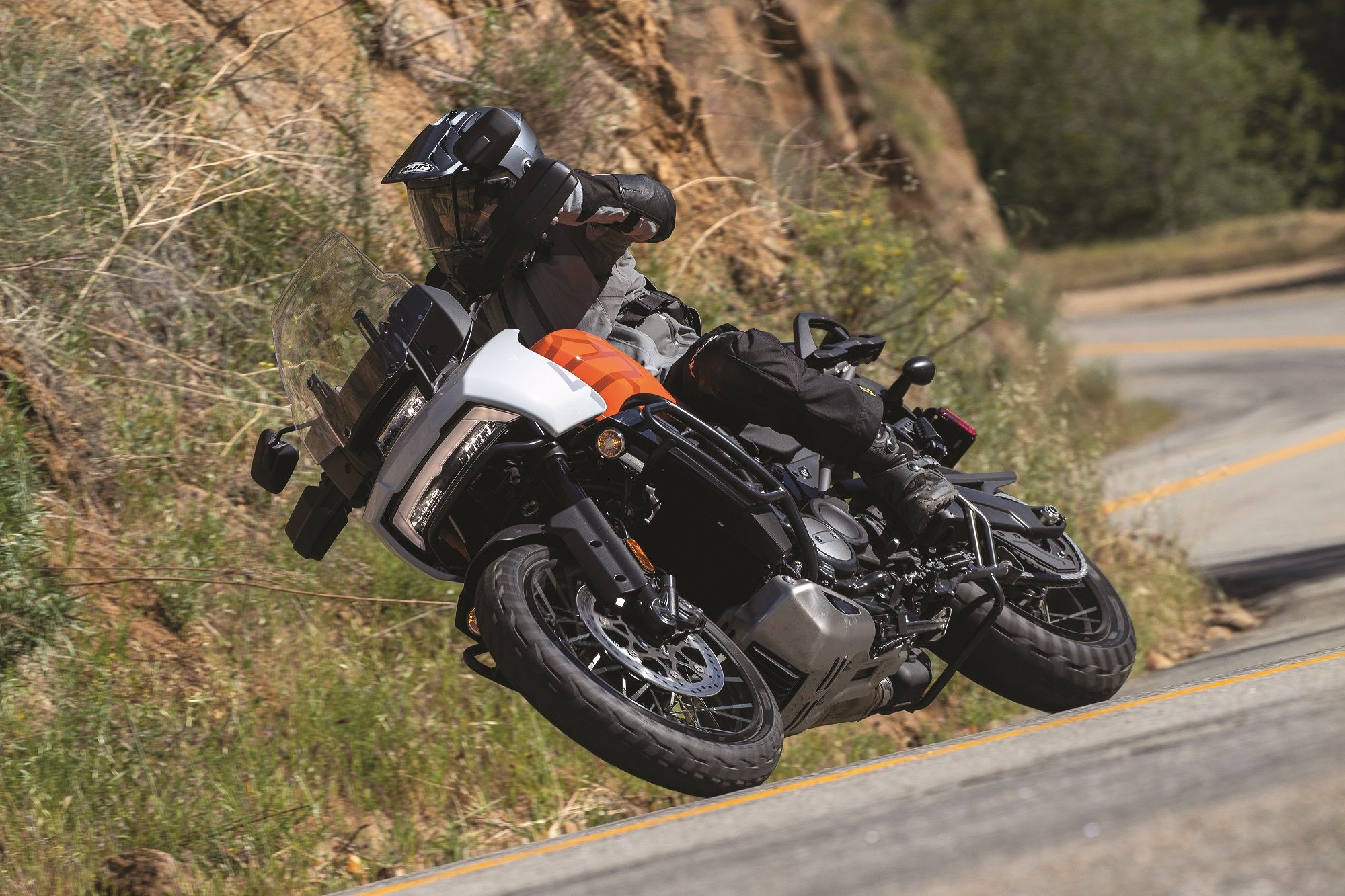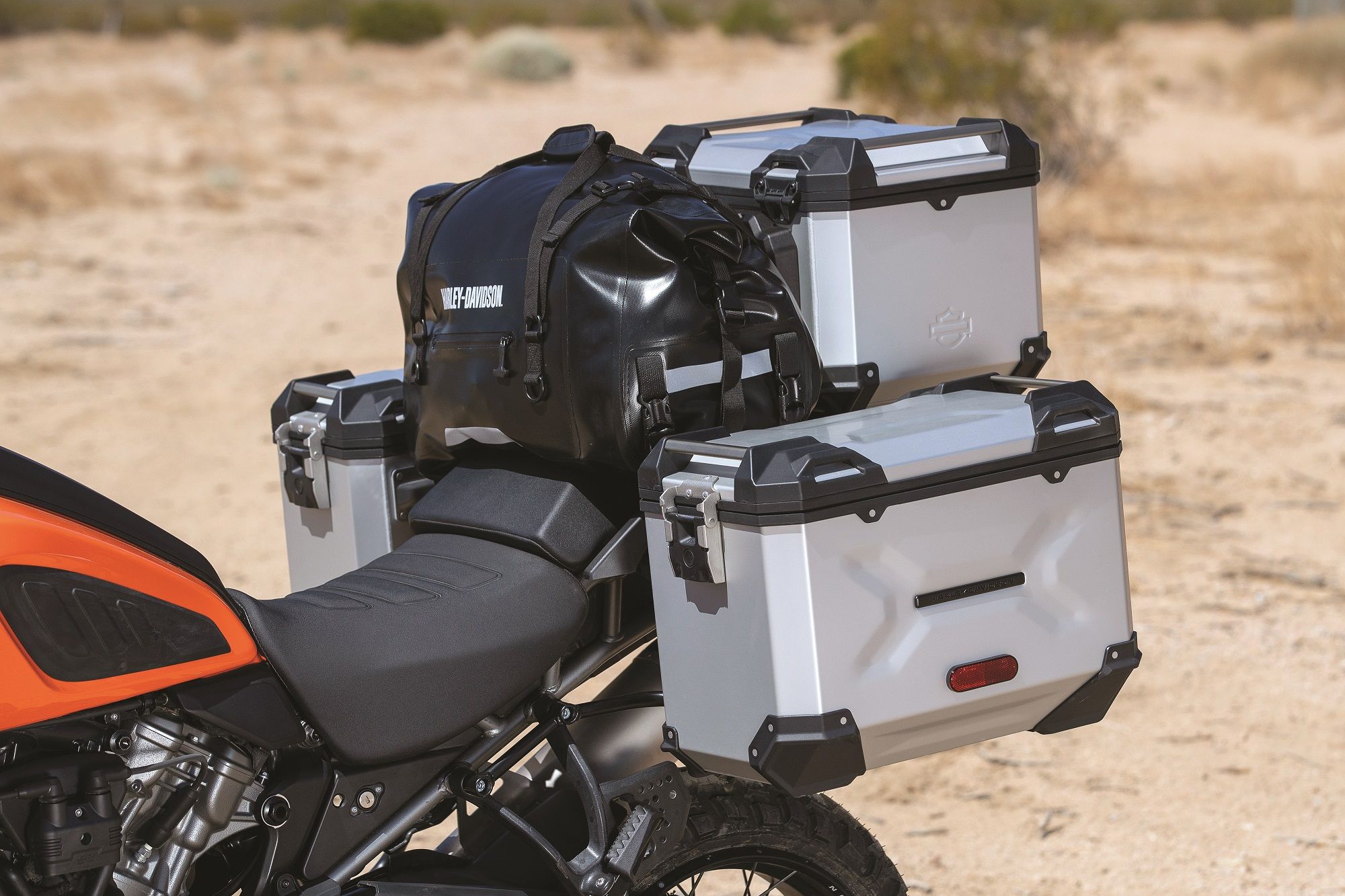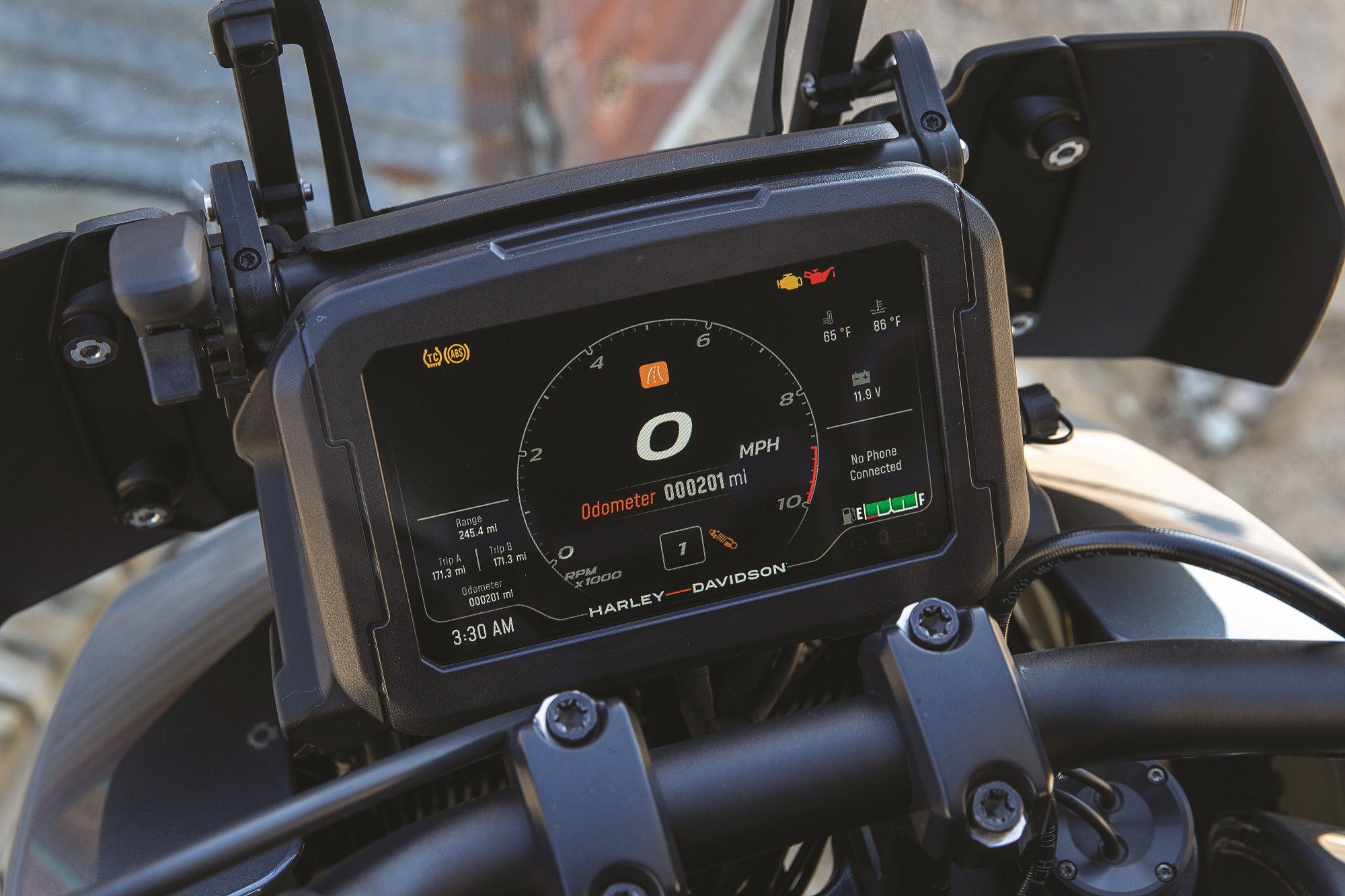Review: 2021 Harley-Davidson Pan America 1250 Special

After riding the new Harley-Davidson Pan America 1250, we’re going to have to reprogram our expectations for vehicles from the Motor Company. This impressive new machine shares absolutely nothing with H-D’s existing products and vaults firmly into the hotly contested adventure market.
To put this intriguing bike to the test, Harley-Davidson invited us to Zakar, a desert compound operated by the RawHyde Adventures riding school near California City, CA. We spent most of the first day testing the sport-touring capabilities of the Pan America (PA) on paved roads around Tehachapi and Lake Isabella, with some mild off-roading thrown in. The majority of our second day was consumed by travel on unpaved roads that culminated at the otherworldly Trona Pinnacles, the backdrop of Planet of the Apes, Star Trek V, and many other movies.

Tech Specs
Technology features prominently on the PA platform, including a six-axis inertial measurement unit (IMU) that informs lean-sensitive traction control, semi-active suspension, cornering-ABS, cornering headlights, hill hold control, cornering-enhanced linked braking, and self-canceling turn signals. Brembo brakes are standard, as is an aluminum tank that helps shave off weight up high. Remarkably, the claimed curb weight for the standard PA is 534 pounds, right in the ballpark for 1200cc adventure bikes. It’s 15 pounds lighter than BMW’s iconic R 1250 GS and some 20 pounds lighter than Ducati’s former Multistrada 1260.
No other bike has H-D’s Adaptive Ride Height (ARH), which is an industry-first innovation that automatically lowers the ride height when coming to a stop to make a tall adventure bike more manageable for shorter riders. It’s a ,000 option on top of the up-spec Special version of the PA, which is the model with semi-active suspension that automatically adjusts rear spring preload to a 30% sag value. The ARH lowers the ride height by one to two inches, depending on the preload setting for a particular load, bringing the seat height down to as low as 30.4 inches (laden, with a 180-pound rider) with the standard seat or to 29.4 inches (laden) with the accessory low seat. Short-legged ADV riders rejoice!

Revolution-ary
The cornerstone of the PA is its new Revolution Max 1250 V-twin engine, to which the front frame, the aluminum mid-frame, and the tail section bolt directly to. This design reduces overall weight. The engine has the same bore and stroke as H-D’s former V-Rod series, but it shares absolutely nothing else except for its 60-degree cylinder layout. It has all the features of modern engines, including double-overhead cams, four valves per cylinder, liquid cooling, and dual counterbalancers. Pricey but lightweight magnesium is used for the engine covers.
To this, H-D adds variable valve timing that broadens the spread of power. It pulls really strongly from low revs and then surges in the midrange to 94 lb-ft of torque at 6,750 rpm. It reaches peak output at 9,000 rpm with 150 horsepower, H-D’s mandatory target for the Revolution Max. Top performance is obtained with premium fuel, but a knock sensor allows it to run safely on lower-grade gas.
And keep in mind that the PA’s hydraulic valves never need adjusting, which one-ups the Ducati Multistrada V4’s best-in-class 37,000-mile valve service intervals.

Special Care
Pricing for the PA begins at $ 17,319, and it includes fully adjustable Showa suspension with 7.5 inches of travel at both ends, cruise control, engine guards, and a windscreen adjustable with one hand to four positions. Side-exit valve stems are a nice touch.
But it’s the $ 19,999 Special that’s, well, special. It includes welcome niceties like the adaptive headlight that illuminates the inside of corners based on the bike’s lean angle, as well as heated grips, a skid plate, a tire pressure monitoring system (TPMS), a centerstand, an Ohlins steering damper, and hand guards. The extra equipment bumps curb weight up to 559 pounds.
Oh, and let’s not forget about the Special’s semi-active suspension, a desirable feature on adventure bikes that have relatively long travel. The electronic Showa components automatically change damping as you ride, taking into account the selected ride mode, vehicle speed, gear position, and acceleration and braking forces.
Nothing but the best for us, so we were set up to ride only the Specials, all with the cool ARH feature. We’d ride the first day on the bike’s cast aluminum wheels, shod with dual-compound Michelin Scorcher Adventure tires. The second day we rode on the accessory side-laced tubeless wheels (0 extra) with Michelin Anakee Wild knobby-style rubber, also in the PA’s standard tire sizes: 120/70-19 front, 170/60-17 rear. The spoked wheels have proven strong in lab testing, but they come at the cost of some 14 pounds of extra weight.

A Beauty or a Beast?
The styling of the PA has been controversial, with the most scathing comments referring to its nose as a toaster. After being around and aboard it for a couple of days, I’ve warmed up to its distinctive appearance. No one can say it’s beautiful, but beautiful adventure bikes don’t really exist. I’m pleased H-D turned away from the front-fender beaks commonly applied to ADV bikes.
I also appreciate how the rectangular headlamp array of 30 LED elements draws styling inspiration from the Fat Bob and Road Glide. The Special’s aforementioned inside-corner illumination works via six LED panels above the main headlight. Cockpit Features
To best fit my body size, I selected the stock seat set to its low position, which allowed me reasonable purchase on the ground when stopped, especially when the ARH brings the seat even lower to the ground. Tall riders will prefer the seat in its higher position, as the seat-to-peg distance isn’t especially long to preserve cornering clearance when sport riding. H-D says the bike has 42 degrees of lean angle before footpegs skim the road.
The PA features a generously sized 6.8-inch TFT color panel topped with the kind of non-reflective premium glass used on smartphones. It can be operated by touchscreen inputs or by handlebar switches, and it can also be linked to your phone via Bluetooth, with navigation provided through a free H-D app.
It’s a nice-looking instrument panel, but some of the text on the screen is quite small, especially considering the generous amount of real estate available on the large display.

Fire In The Holes
H-D designed the Revolution Max motor with connecting rod journals offset by 30 degrees to mimic the firing order of a 90-degree V-twin. To my ears, it sounds like a mix of a V-Rod and KTM’s 75-degree V-twin, which is a pleasing soundtrack.
I began our ride in Sport mode, which is one of the four ride modes available to deliver different engine responses, as well as corresponding settings for the suspension and electronic rider aids. The Special has two additional modes that can be customized.
Throttle response in Sport is definitely sporty, with an abruptness during throttle reapplication. I switched over to Road mode and enjoyed the smoother throttle, although I did miss a bit of the aggression of power ramping up in Sport. So I created a Custom configuration based on Sport but with softer throttle response and less engine braking, which satisfied my personal preferences.
The PA’s saddle is a pleasant place to be while munching miles, with a comfortably upright riding position and four choices of windshield placement to suit different rider sizes. Oddly, there are no clear detents to feel when moving the windscreen through its 1.8 inches of adjustment. Also, I was disappointed to notice the mechanism for moving the screen became recalcitrant on a few bikes after riding in all the dust on the second day of our trip.

Sport-Touring
Big ADV bikes have evolved to become top choices for sport-touring, and the PA serves you well when hustled down a twisty road, feeling not dissimilar from the Multistrada V4 we tested in our Jun ‘21 issue. I’d give the Ducati a slight edge in agility. Surprisingly, the steering damper isn’t an electronically adjusted type, so its damping is static. This dulls steering quickness at low speeds when a damper isn’t really necessary.
Otherwise, the PA was delightful in carving the corners of Caliente-Bodfish Rd, with excellent stability when leaned over. The Brembos provide a strong response without being overly touchy, and the linked function is nearly imperceptible. The gearbox is decent if not excellent, although it is let down by not having a quickshifter like some other bikes in this class.

Getting Adventurous
The final part of our first day traversed about 10 miles of unpaved roads, and the PA felt at home in this mildly technical environment. The Special offers three ride modes for the dirt. I chose Custom Off-Road Plus for its lenient restrictions on electronic interventions, as well as for switching off the rear ABS and linked braking. Traction control can be disabled anytime by a long press on the TC button.
The motor pulled strongly and smoothly from down low, providing exactly as much thrust as desired, whether just a little to tractor out of a sandy corner or more than enough to slide the back end in a controllable drift. The Michelin Scorcher Adventures performed surprisingly well in the dirt for such a good street tire.
Through it all, the PA was intuitive and relatively easy to handle. The most unpredictable moments came when setting the bike on its sidestand. Its tab is deployed at an odd place ahead of the shifter, which is a little awkward, and the adaptiveness of ARH causes the bike’s lean angle to be inconsistent when parked. ARH can be switched off if preferred.

Off the Roads
The test fleet was outfitted with the wire-spoke wheels and Anakee Wild tires for our trek to the Trona Pinnacles, with stops at the Burro Schmidt Tunnel leading nowhere and lunch in Randsburg. These tires squirmed and lacked grip on paved roads, but they were a godsend when piloting the 550-pound dirtbike in sandy soil.
Again the PA surprised me with its off-road capabilities, feeling even more adept than the fun Multistrada. It tracked fine in sand, and its magical motor doled out power in a predictable manner. I was able to use second gear in turns that seemed more appropriate for first gear.
Like many other ADV bikes, the PA suffered axle tramp on washboard terrain, and that caused the centerstand to clank around noisily. Our tire pressures were set to street inflation, 39/44 front/rear according to my TPMS, and I’d expect a smoother and grippier ride had they been deflated some. If you’re going to pounce on rocks or even jump the Hog, definitely choose the firm damping selection from the electronic menu.

The Final Verdict
I’ll admit that I looked down my nose at the prospects of a competitive ADV from Harley-Davidson. That said, I’m happy to report the Pan America is far better than I expected.
It rolls down the road with surety and comfort, it devours twisty roads with sporty fidelity, and it tackles off-road terrain as good as almost anything without a KTM badge. H-D deserves kudos for building a distinctive and convincing player in this combative segment of excellent adventure-tourers.
Technical Specs
2021 Harley-Davidson Pan America 1250 Special
+ distinctive, feature-rich with ARH, brand revolution
– intense class competition, no quickshifter
Distributor Harley-Davidson Motor Company
MSRP $ 19,999
Engine liquid-cooled, 60° V-twin, DOHC, 16-valve
Displacement 1252cc
Power 150hp @9,000rpm; 94lb-ft @6,750rpm
Transmission 6-speed, slip/assist wet clutch, chain final drive
Rake/Trail 25º/6.2in
Wet Weight 559lbs, claimed
Seat Height 33.4-34.4in
Fuel Capacity 5.6gal
Fuel consumption 46mpg (EPA)
Fuel Grade premium
Colors Vivid Black, Gauntlet Gray Metallic, Deadwood Green, Baja Orange
